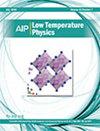各向异性金属中的非局部电输运
IF 0.8
4区 物理与天体物理
Q4 PHYSICS, APPLIED
引用次数: 0
摘要
我们讨论了各向异性金属中非局域电输运的各个方面。对于具有圆形费米表面的金属,进入局部电导率和粘度张量的散射率是定义良好的,对应于线性化碰撞算符的本征频率。对于各向异性金属,我们提供了这些散射率的广义公式,并使用变分近似来显示它们与微观跃迁概率的关系。我们建立了具有有限数量准守恒量的任意费米表面金属的碰撞算符的简单模型,并推导出长窄通道中随波矢量变化的电导率σ(q)和随空间变化的电导率σ(x)的表达式。我们将此应用于动量守恒和动量松弛散射的不同速率的情况,推导出σ(q)和σ(x)的封闭形式表达式-除了从圆形几何推广到任意费米曲面几何之外,这代表了对现有方法的改进,这些方法是数值求解相关微分方程而不是以封闭形式求解。对于菱形费米表面的具体情况,我们表明,如果通过圆形费米表面的模型解释输运特征,则基于实验方向和基于是否考虑σ(q)或σ(x),对潜在输运状态的诊断将有所不同。最后,我们讨论了体积电导率。虽然人们普遍认为“动量”守恒散射不会影响体电阻率,但我们表明,晶体动量守恒散射——如正常的电子-电子散射——可以影响各向异性费米表面的体电阻率。我们为这个贡献导出了一个简单的公式。本文章由计算机程序翻译,如有差异,请以英文原文为准。
On non-local electrical transport in anisotropic metals
We discuss various aspects of nonlocal electrical transport in anisotropic metals. For a metal with circular Fermi surface, the scattering rates entering the local conductivity and viscosity tensors are well-defined, corresponding to eigenfrequencies of the linearized collision operator. For anisotropic metals, we provide generalized formulas for these scattering rates and use a variational approximation to show how they relate to microscopic transition probabilities. We develop a simple model of a collision operator for a metal of arbitrary Fermi surface with finite number of quasi-conserved quantities, and derive expressions for the wavevector-dependent conductivity σ(q) and the spatially-varying conductivity σ(x) for a long, narrow channel. We apply this to the case of different rates for momentum-conserving and momentum-relaxing scattering, deriving closed-form expressions for σ(q) and σ(x) — beyond generalizing from circular to arbitrary Fermi surface geometry, this represents an improvement over existing methods which solve the relevant differential equation numerically rather than in closed form. For the specific case of a diamond Fermi surface, we show that, if transport signatures were interpreted via a model for a circular Fermi surface, the diagnosis of the underlying transport regime would differ based on experimental orientation and based on whether σ(q) or σ(x) was considered. Finally, we discuss the bulk conductivity. While the common lore is that “momentum”-conserving scattering does not affect bulk resistivity, we show that crystal momentum-conserving scattering — such as normal electron-electron scattering — can affect the bulk resistivity for an anisotropic Fermi surface. We derive a simple formula for this contribution.
求助全文
通过发布文献求助,成功后即可免费获取论文全文。
去求助
来源期刊

Low Temperature Physics
物理-物理:应用
CiteScore
1.20
自引率
25.00%
发文量
138
审稿时长
3 months
期刊介绍:
Guided by an international editorial board, Low Temperature Physics (LTP) communicates the results of important experimental and theoretical studies conducted at low temperatures. LTP offers key work in such areas as superconductivity, magnetism, lattice dynamics, quantum liquids and crystals, cryocrystals, low-dimensional and disordered systems, electronic properties of normal metals and alloys, and critical phenomena. The journal publishes original articles on new experimental and theoretical results as well as review articles, brief communications, memoirs, and biographies.
Low Temperature Physics, a translation of the copyrighted Journal FIZIKA NIZKIKH TEMPERATUR, is a monthly journal containing English reports of current research in the field of the low temperature physics. The translation began with the 1975 issues. One volume is published annually beginning with the January issues.
 求助内容:
求助内容: 应助结果提醒方式:
应助结果提醒方式:


